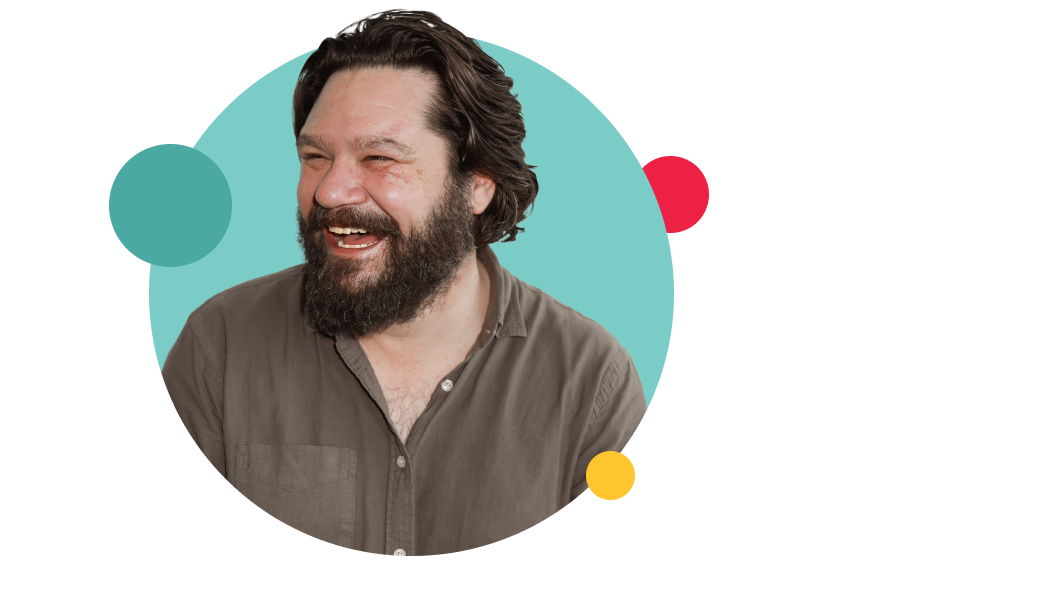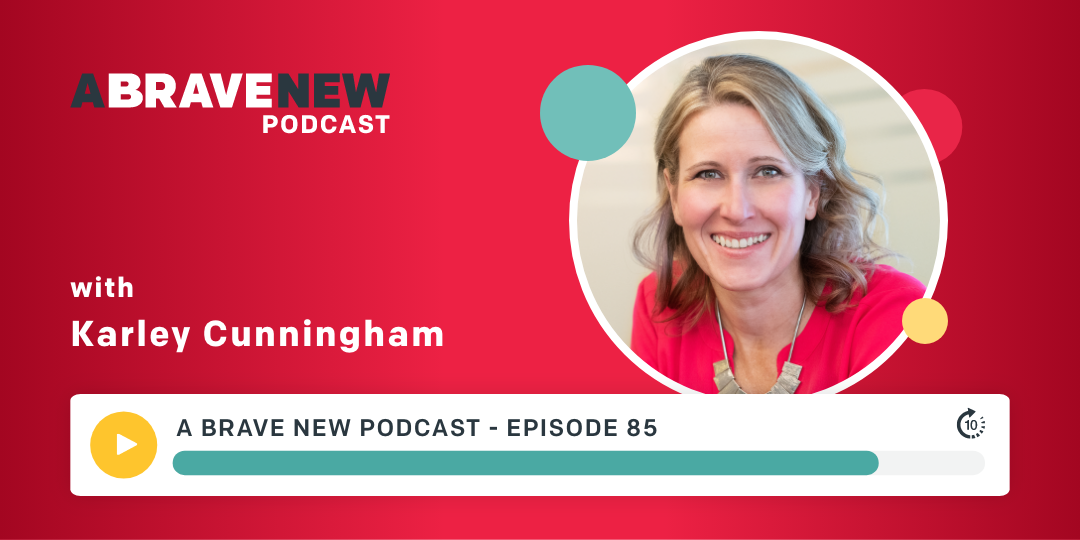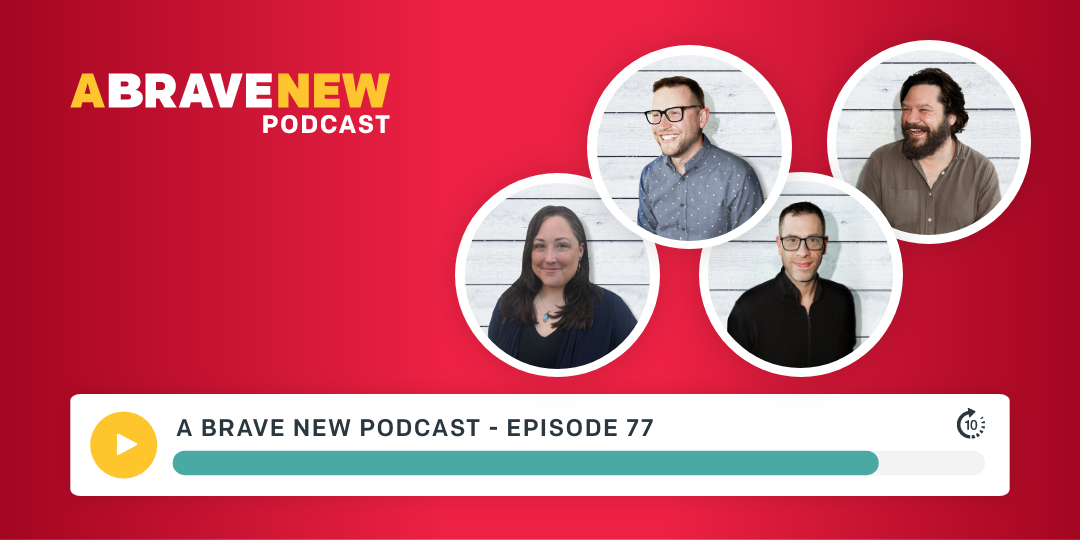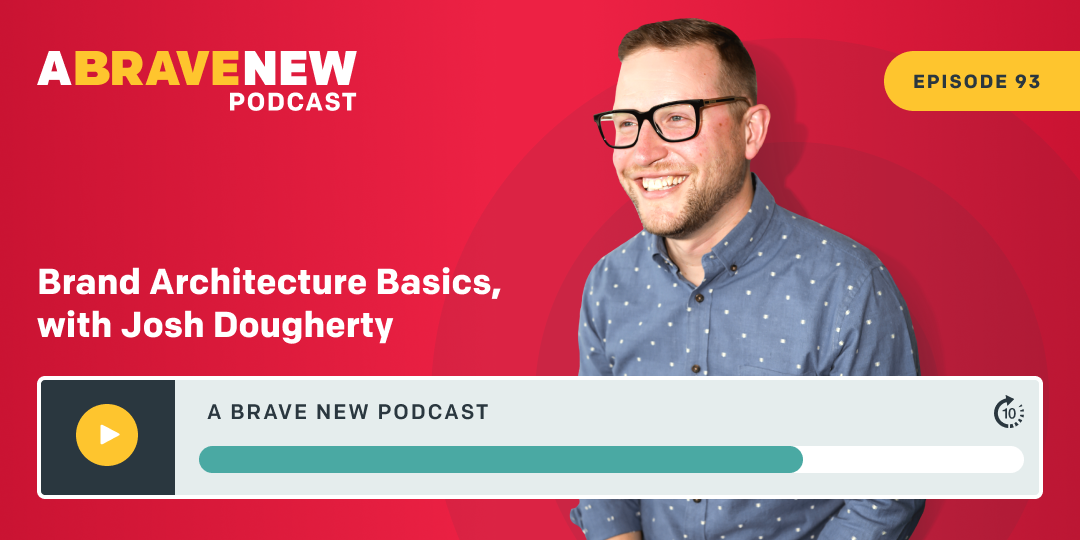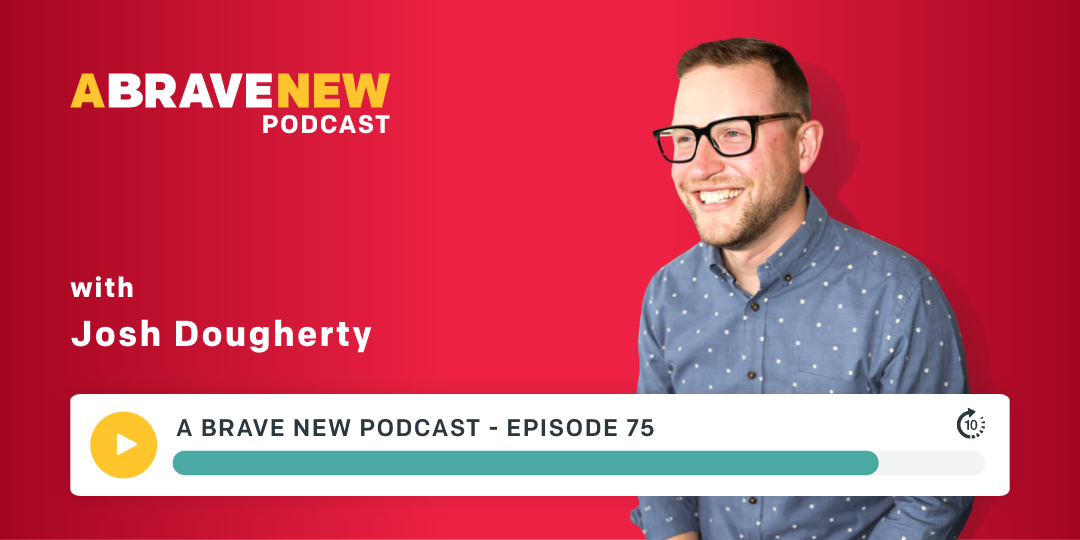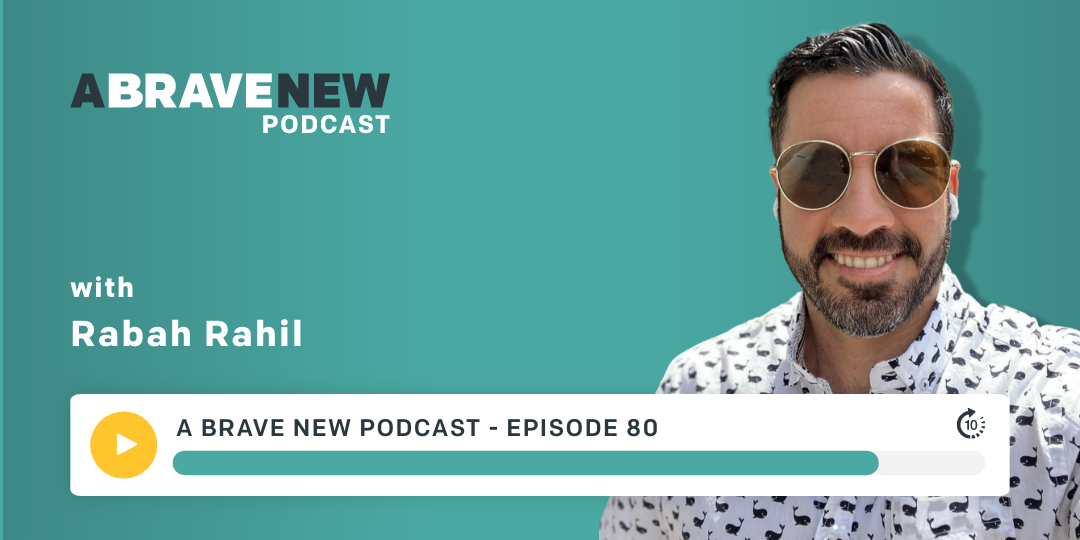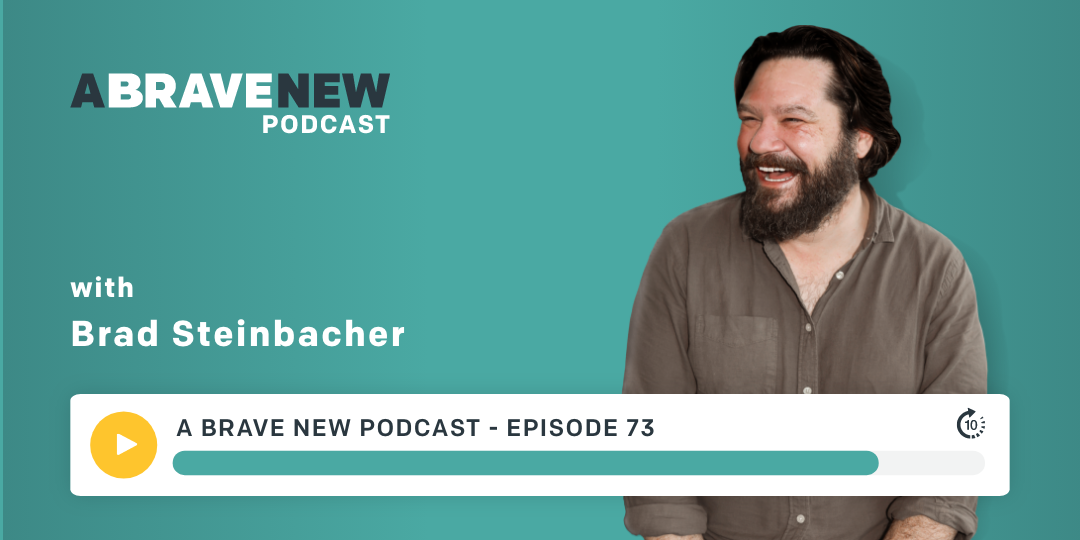Josh Dougherty is a brand strategist, speaker, and the founder and CEO of A Brave New, a Seattle-based branding agency that crafts bold and memorable healthcare brands. They have specific expertise in healthcare technology, employee health and wellness programs, and hospitals and providers. Josh has 15 years of experience building new brands from scratch, refreshing existing brands, and building strategies to bring those brands to life in the market.
In this episode, Josh is joined by A Brave New’s content director, Brad Steinbacher, to discuss how health tech brands can develop distinctive and memorable brand positioning. Brad has more than 15 years of experience creating content for brands across industries with a special focus on healthcare and technology.
What you’ll learn about in this episode:
- The opportunity brand positioning offers for health tech companies, especially startups
- Why brand positioning isn’t always prioritized as it should be
- Why moving beyond just speaking clearly about your product and features is essential
- Real-life examples of brand positioning
- Specific ways to build differentiation with your positioning and visual identity
Additional resources:
- Josh Dougherty on LinkedIn
- Brad Steinbacher on LinkedIn
- Josh Dougherty’s speaking site
- A Brave New’s Website
Transcript
Josh Dougherty:
Welcome to A Brave New podcast. This is a show about branding and marketing, but more than that, it's an exploration of what it takes to create brands that will be remembered and how marketing can be a catalyst for those brands' success. I'm Josh Dougherty, your host. Let's dive in.
Hello and welcome to the show today. Today, we're going to talk a little bit about brand positioning and health tech space. And unlike a normal episode where I have a monologue with myself or some external guests, I have Brad Steinbacher, our content director here with me today. Hey, Brad, how's it going?
Brad Steinbacher:
Great, thanks for having me.
Josh Dougherty:
Yeah, of course. So we're going to talk about brand positioning. But before we dive into that conversation, I wanted to frame up what we're talking about, and I think this is really a conversation for people who are either starting or accelerating their health tech startup and building it out, trying to get traction in the market. And the thing that we've found over the years is that the typical journey for someone as they head down that way is they're really focused on two things and that's the product. Do we have the kernel of a product idea that works really good? And is it cool? Does it solve a problem? And then they're also focused on funding.
And then once they get funding, whether from a VC or they get from some other funding source, they then focus in on making sure that they can sell a bunch of whatever the product they're selling, whether this is a SaaS product or it's something that's more enterprise level. The focus is on sales and then continuing to enhance the product but again, not so much on positioning and branding.
And then when we get down the line, someone starts, maybe you're a few years into the process of building out your health tech. You have a website, you have some customer base, you have momentum, and you start looking and comparing yourself against the competition. And you see that you don't really stand out at all because you're talking about maybe AI or the AI elements of your product all in the same way as everyone else, or you're just highlighting some of the features that you have, but you sound just like the rest of your competition.
And so we're trying to identify today if you find yourself in that place or if you don't want to find yourself in that place, how can you start building a brand from the get-go that is going to give you the ability to stand out, to make great connections with your customers, and to build authentic relationships and trust? And that's a bunch of words, but I do think it's important context. Brad, I'd love to hear from you as you think about building brands that connect with people, and especially in this health tech space, what's the paradigm that you're using to think about it?
Brad Steinbacher:
Yeah. I mean, it is an interesting topic because so many brands in the health tech space, they think standing out means coming across as innovative and modern, and like you said, then they look around and they look similar and sound similar to other companies in that space. And presenting yourself as cutting edge and modern, it's fine on the surface level, but you should really be thinking about your brand as a problem solver. Your product solves a specific problem for someone. And unfortunately, nowadays it seems like the go-to is AI. You slap AI onto your website and that tells a story about how you're solving these problems, but you really need to take it down to the human level and understand what the people that you want to sell to have as a problem and then reverse-engineer your marketing so that your product explains how you solve that problem. Does that make any sense?
Josh Dougherty:
Yeah, I think it makes a lot of sense, and I think it's ironic that ... Well, maybe not ironic, but it's interesting that it often doesn't make it into the marketing or the positioning. Because in the design of the product, I think most founders, most people, are working on the technical side of things, are thinking about the problem that they're going to solve/ But then it doesn't end up being expressed in the messaging about the product that they built, that it’s solving a specific real-world issue.
Brad Steinbacher:
Yeah, you need to make it so people relate to it, to what you're trying to solve and understand how your product solves it and how they should go with you as a company and your brand as opposed to other ones out there who are working in the same area.
Josh Dougherty:
Yeah, awesome. So I think we're going to do that today with three main parts of the conversation. First, we want to talk about some big principles around how to differentiate and I think how to differentiate specifically in this space.
Then we want to share some examples of why simply relying on a product doesn't work or why relying on talking about your technology doesn't work alone. And we'll do that by looking at some real-world examples of companies. We will not name names of these companies, but we will share their taglines that they have on the front of their website and have a conversation about them.
And then the final thing we'll do is we'll talk about maybe three practical examples of how to build differentiation in your space as you're thinking about positioning your product. But first, we need to dive into the big principles, and to do that, we think, at A Brave New, about kind of a Venn diagram of how to position a brand in the health tech space. Brad, I wonder if you could talk a little bit about that Venn diagram and how those pieces fit together.
Brad Steinbacher:
Sure. So, especially in the health tech space, the Venn diagram place where you want to be with your brand and your marketing is in the overlap. On one side, you have tech and science, which is important to get across that you're knowledgeable and that you can be trusted and you're innovative. But on the other side, you have probably a bigger circle that is just human. You want to come across as human, that you understand humans and their problems. And so you want to be right in between, in that overlap where you show both sides of it that it's not just about the tech, it's about helping people that have problems. I mean, yes, it's health technology, but there's nothing much more personal than healthcare and more human than your human body and healing and dealing with issues like that. So that's exactly where you want to be. And it's a hard place to hit, it's definitely a balancing act, but that's where I feel you need to really drill down and focus on.
Josh Dougherty:
Yeah, I think it's really hard even when you get into a solution like, if you're doing revenue cycle management for healthcare, that's something that has a lot of traction in the health tech space. How do we help people become more efficient, generate more revenue with their systems, etc.? And you're like, "How the heck do we make that feel human?" I think, somehow, you have to build the connection with like, "How does this help patients? How does this help physicians do their jobs better? How does it free up the healthcare provider, the hospital, to do better work for its patients?" There's got to be some end line connection to the real world other than, well, I suppose you can just sell by saying, "We're going to make you more efficient and make you more profitable as an organization, even if you're a nonprofit healthcare organization," but I don't think it's a particularly compelling argument, I should say.
Brad Steinbacher:
Yeah, I agree. I mean, one thing to keep in mind is that healthcare providers got into it because they want to help people, and it's not just about making it so their day is easier, it's that they can provide better care.
Josh Dougherty:
I think that's true even of administrators, a lot of times they've come from that healthcare perspective or care-providing perspective, I guess.
Brad Steinbacher:
Yeah, I mean in healthcare, tech is something that if your product actually helps people get better, then you know it's working, and it speaks to everybody even up to the C-suites, like, "Oh, okay, I understand we are helping people and that's why we're being successful."
Josh Dougherty:
Yeah. So, I think, keep in mind that North Star. How do you highlight the technology, the science, the innovation that's coming out of your product, which is going to make people buy it? But, also, how do you showcase that human impact, whether it be human impact for the internal staff and the healthcare organization, for their patients, for the outcomes that they're going to be able to drive? There's got to be some connection there and it has to be believable.
So that's kind of our big argument, this Venn diagram, humanity on one side, tech and science on the other. You need to find that middle space that highlights both. And that is, I don't know, a proposition that we would make, but let's show you a little bit why we think that proposition is true. In preparation for this episode, Brad and I looked at like 300 different organizations, so think it was that much, Brad, as we were scrolling through?
Brad Steinbacher:
It certainly felt like that much.
Josh Dougherty:
Lots of URLs. We were just looking at them and trying to understand like, "Sure, we will operate in this space, but let's look at a bunch in a row." And so we chose five examples of that positioning that we believe doesn't hit the mark, I should say, and doesn't differentiate someone. And then we're going to share five here. I'm going to read them to Brad and ask him to guess what part of the health tech space this company works in. The first one is, "AI-powered innovations for a healthier tomorrow." What do you think this company does, Brad?
Brad Steinbacher:
Well, something with AI, but I don't know exactly what that AI is doing to make ... wow, that's just a lot of words that are buzzwords. Is it like a back end, like patient records software that uses AI?
Josh Dougherty:
It is not quite that, no.
Brad Steinbacher:
I honestly have no idea what they're trying to say that they do here.
Josh Dougherty:
Yeah. So this is a care coordination platform, one that helps people bring together analytics interoperability, like different electronic health records, etc., to help coordinate care better for patients. So, missed opportunity.
Brad Steinbacher:
This is the major problem with these things is, "AI-powered innovations." Nobody understands that. Nobody knows what that even is. I don't even think they know what it means. So you’ve got to cut through that type of nonsense to actually make an impact.
Josh Dougherty:
Yeah, exactly. Well, we'll talk about how to fix that in a second. Let's go on to our next one. This next company says, "Our mission is to improve patient outcomes with AI-powered pathology." Better, right?
Brad Steinbacher:
It's better. It's more specific with the pathology point, but then again, what does the AI power give you that you can't get otherwise in pathology is the question. It needs to be answered, and maybe they do on their website.
Josh Dougherty:
Yeah, I think they do a little bit. These people talk about how they're using AI to improve patient outcomes and the pathology and biopharma space, so I think it's a little bit better. The general, I don't know if it's a critique, but the area I would work on improving here is moving beyond just stating what you do to building on some emotional connection into what you do and getting a little bit more specific as well, actually.
Brad Steinbacher:
Yeah, I mean improved patient outcomes is definitely an industry buzzword, but helping patients, get the help you need faster or whatever, that sort of sentiment of like, "This is what our product does."
Josh Dougherty:
Yeah. All right, so the next one here is, "Trusted intelligence, simpler decision-making, and better healthcare."
Brad Steinbacher:
I don't actually dislike this one as much because trusted intelligence leans into the AI and the analytics thing. Simpler decision-making is the problem that their platform solves and they're playing about that, and better healthcare builds off of simpler decision-making leads to better healthcare. So I think that one's decent.
Josh Dougherty:
Yeah, great.
Brad Steinbacher:
I don't know what they do, but-
Josh Dougherty:
It has a value proposition to it.
Brad Steinbacher:
Exactly.
Josh Dougherty:
We're also cherry-picking a little bit, because we aren't talking about the whole website, we're taking the first line off their website.
Brad Steinbacher:
That's very true, but it's the first line for a reason.
Josh Dougherty:
Yeah, I think this organization, too, focuses on connecting together data and organizations so they're all talking to each other. And they do a better job as they scroll down on their websites. Talking about the solutions and about how they all use the intelligence makes sense when they're talking about, "We help people prescribe better, we help them, their EHRs communicate better together. We help the prior authorization of drugs to be made more smart, not just like a rote, 'Yes, we approve this type of therapy, but not this type of therapy.'"
So I think, then, you start to see the value proposition lived out. So, certainly keep in mind that you need to look at your whole site and everything you're presenting as a package, but I do think you've got to catch the person at the top of the page and make them think, "Yes, I'm interested in that," before they get going.
Brad Steinbacher:
Yeah, I would absolutely agree with that.
Josh Dougherty:
Next one, "Synchronizing healthcare data for unmatched insights."
Brad Steinbacher:
This just looks like a database company — that they have some sort of back-end database where they can pull healthcare data and I guess organize it?
Josh Dougherty:
And you would be kind of correct.
Brad Steinbacher:
Well, at least they didn't say AI.
Josh Dougherty:
They have a data ecosystem that people can tap into, so that people can get healthcare and consumer data and then pull it together to get intelligence about their patients. So that's good. And then the final one is, "More precise, real-time health intelligence, more impact."
Brad Steinbacher:
That just says nothing really to me. I mean, I feel like it does the exact same thing as the third and fourth ones we talked about, but there's nothing really actually interesting about that.
Josh Dougherty:
And so again, this is, I think as you go down into this, they talk about how they have a fully integrated population health management platform that helps value-based care organizations to seamlessly leverage insights and macro-level strategies, which I think is a little bit more specific and better. But , again, we have an opportunity to share that up top and maybe build some connection with people because the "More precise, real-time health intelligence, more impact," for me doesn't get me thinking down the line of what they're going to say next on the site about their population health management.
Brad Steinbacher:
Yeah. And it doesn't talk about why, I mean, you can guess why, imprecise health intelligence is bad, but is it this huge problem across the industry that everybody is clamoring for a solution for or is it just added bells and whistles?
Josh Dougherty:
And so I think regardless of what we do, this is just to share a little bit about how everyone's talking similarly. Because I guess at the end of the day, and if you're listening, you're like, "Hey, that was my tagline on one of these sites that you just talked about or ripped into." I do agree that it's the whole story that you're telling on your website, so maybe don't feel too bad, we're taking a paragraph or sentence and we know that we're pulling it out of context. But I think the thing that this illustrates is if you look at these five, they all use a very similar language and there's no real ... I think in many ways you could copy and paste and put those statements on any of those five websites we talked about and it wouldn't have a super adverse impact because they're all kind of talking about things in the same way.
Brad Steinbacher:
Yeah, I think so. And look, this is hard to get in this space, to get the human in the space when you're talking about data pools and coordinated care among data, it's a challenge.
Josh Dougherty:
So we've exposed the challenge a little bit in real world, I think. Let's talk about three ways to build in that science-human differentiation and how to differentiate yourselves because, obviously, everyone could talk about the science side and our human side similarly, but how do you make sure you're telling your own unique story? There are really three principles I think we think of when we're working on positioning for organizations in this space.
The first one is to not talk about yourself but to talk about your customers. And, Brad, can you expand a little bit on this? I think this is something we think about a lot from a marketing and communication perspective, but how do you think people should think about that?
Brad Steinbacher:
Yeah. I mean, it's all about making a connection no matter who your customer is. Let them understand that you know their problem, why it's a problem, and you created this thing to solve that problem. So don't lead with talking about how innovative and great your new device or platform is. Lead with talking about why people need your platform and then you can build upon that to show how and why it is so effective to help them with those problems.
Josh Dougherty:
Yeah, no doubt. I think about this whenever we're doing persona interviews with someone and we talk about what is the thing that keeps the person up that we're selling to, keeps them up at night worrying. And if your initial positioning can speak to that worry or that concern that they have and help them see themselves in your organization, you're going to build instant credibility with that person.
Brad Steinbacher:
Yeah.
Josh Dougherty:
The next thing I think we think of is being less solution-focused and more benefit-focused. Can you talk a little bit about that, Brad?
Brad Steinbacher:
Yeah. I mean, it's similar to the first one, but you want to be able to deliver the information about what your solution is in a way that actually they, A, understand it. And also, B, they get it. There's a difference to me between understanding and getting, where getting is sort of like you can apply it to yourself, you can apply it to what you want to have happen with it. That's generally it. And again, going back to creating that emotional connection between a platform of data, but it has to affect somebody and this is how it's going to affect you in a positive way.
Josh Dougherty:
I think a real practical example of this is like solution-focused, and I'm not picking on anyone here. I'm coming up with this out of my mind, but you go to a lot of websites and electronic health records are a common thing in this space. So you hear a lot about the electronic health record for optometrists, very solution-focused. Tells you exactly what it is, tells you who it's for, which is half a positioning. But, it doesn't connect with anyone on the emotional or real needs that an optometrist has. One of the things that they have is they have patients that come in on an annual basis and you need to get them in on time and keep them flowing for your business to succeed. You need to be able to specifically manage both the appointment booking side of things in an optometry practice but also the sale of eyeglasses and all these sorts of things. And so you need to be able to have something that's going to manage that seamlessly.
And so, there are a number of different factors that you could talk about like, "We are the best electronic health record for optometrists," but if you really are, you should understand the specific problems and what has been designed specifically inside of that electronic health record to make an optometrist want to use that versus one of the, I would say, much more well-known solutions that is agnostic to the health practice that they're working in. Because, why wouldn't they want to use something that maybe has higher adoption across the industry versus your specialized thing? You've got to make that case. You can't just say, "We are the specialized thing."
Brad Steinbacher:
To spin off of that a bit, in my previous life, I did marketing for public affairs and some politicians and stuff like that, and one of the things we often said was, "You don't try to get somebody from no to yes. You try to get them from no to maybe." And that maybe is when they start to realize, "Okay, this is going to actually benefit me. This is something that I need that I may not have known that I needed," but they're open to it. Instead of just coming out there saying, "We're the most innovative, you should use us" right away. That's not going to move the needle at all.
Josh Dougherty:
A little bit of that show, don't tell basics that I think we all forget.
Brad Steinbacher:
Yeah.
Josh Dougherty:
And then the other thing I think that we think about is how to use design to differentiate. So I would encourage you to do this if you're in this marketing space: go and open up 10 to 15 health tech websites and look at them. And I would guess that you're going to find a lot of images of someone in a lab coat with a stethoscope. You're going to find some technological graphics and iconography. And then you're going to find a lot of pictures of smiling people with stat graphs and icons over the top of them, and then probably some cool sketches, like illustrations of healthcare folks. And so this is the last area where I think there is ... And I don't know if we know the solution with this, we struggle with this on every, I think, project we do, but what does it mean to look different from the other health tech solutions and not just repeat the well-worn path of the same kind of design motif that is used across this industry?
Brad Steinbacher:
Yeah. And I think a lot of that is trying to make it so your website doesn't look like it was something from Squarespace. Nothing wrong with Squarespace, but it seems like a lot of these sites have a very similar feel and construction and hierarchy and stuff. It just feels like a missed opportunity, and you're not going to stand out if you look and feel like everybody else in your area.
Josh Dougherty:
Yeah. And so I think some real practical ways that you can think about that is one, do some color theory work to look at your main competitors. If you work in the area of population, like providing a care navigation platform, look at the different care navigation platforms and look at ... I guarantee there are likely clusters of people using all the same colors in your industry. Think about what colors can we use that would break out of the mold? Then, think about what are some design motifs that we can use differently? I think this is where a strong competitive and getting stuff on a digital whiteboard or even on a whiteboard printed out on a wall is the old-fashioned way we would've done it to see like, "How do we stand out differently?" And then, thinking of some design approaches that differentiate from the rest of the top 10 people you're selling against would bear so many dividends to be able to stand out differently.
Brad Steinbacher:
Yeah. And don't go overboard with trying to be a super cool website. Build it from the problem solution and then you can make it pretty after that.
Josh Dougherty:
Yeah. Great. So this has been a shorter episode today, but hopefully you found it valuable for us to take a look at what it means to build a good healthcare technology brand, one that's bold and memorable and different.
Well, we hope that you'll keep in mind the Venn diagram and how you kind of fuse together the human side of the impact that your work has and the science and technology side of the tech solution that you're bringing, and that you can use this to think a little bit more in depth about your brand positioning as you move forward building out your business as you head into the second half of 2025. Thanks for joining me today, Brad, for the conversation. Really appreciate it.
Brad Steinbacher:
Thank you.
Josh Dougherty:
Thanks for listening to this episode of A Brave New Podcast. Go to abravenew.com for more resources and advice on all things brand and marketing. If you enjoyed this episode, show us some love by subscribing, reading, and reviewing A Brave New Podcast wherever you listen to your podcasts. A Brave New Podcast is created by A Brave New, a brand and marketing agency in Seattle, Washington. Our producer is Rob Gregerson of Legato Productions.
Similar Articles
OCT 11, 2021

The Beginner’s Guide to Generating Inbound Leads
Marketing doesn’t have to be painfully intrusive, like getting yet another telemarketing call right when you sit down to dinner with your family.
OCT 11, 2021

The Beginner’s Guide to Generating Inbound Leads
Marketing doesn’t have to be painfully intrusive, like getting yet another telemarketing call right when you sit down to dinner with your family.

